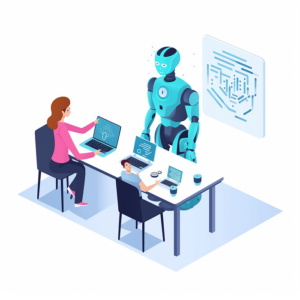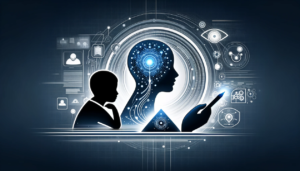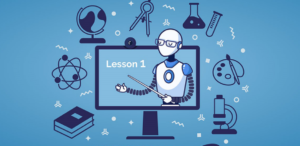The AI Revolution in Education
The fusion of artificial intelligence (AI) and education software is no longer a futuristic concept—it’s transforming classrooms, online platforms, and learning models around the world. From adaptive learning systems to intelligent tutoring tools, AI is personalizing education like never before.
Whether you’re an educator, a parent, or a student, understanding how AI personalizes learning will open your eyes to the profound benefits this technology brings to education.
1. Adaptive Learning Paths Tailored to Each Student
One of the most powerful features of AI in education is adaptive learning.
How It Works:
- AI tracks a student’s performance in real-time.
- It adjusts difficulty levels, topics, and delivery style based on progress and weaknesses.
- Algorithms select the next lesson or module dynamically.
Benefits:
- Students don’t move forward until they master previous content.
- It prevents boredom for advanced learners and reduces frustration for struggling students.
- Teachers get performance data for intervention.
2. Intelligent Tutoring Systems That Simulate Human Guidance

AI-powered intelligent tutoring systems (ITS) mimic one-on-one tutoring by identifying where a student is struggling and offering real-time help.
Key Features:
- Natural language processing to understand student queries.
- Step-by-step guidance through problem-solving.
- Encouragement and feedback tailored to the student’s learning style.
Why It Matters:
- Supports students who can’t access a live tutor.
- Helps build student confidence and retention through targeted help.
- Functions 24/7—ideal for remote or self-paced learning.
3. Personalized Content Recommendations Like Netflix for Learning
AI in education software can recommend content (videos, readings, quizzes) based on what students need to learn next—just like Netflix recommends what to watch.
Example Tools:
- Khan Academy’s AI-driven content suggestions.
- Edmodo and Classcraft’s personalized activity feeds.
How It Helps:
- Learners stay engaged with relevant materials.
- Reduces time wasted searching for study materials.
- Enhances knowledge retention through repeated exposure to key concepts.
4. Predictive Analytics That Spot At-Risk Students Early

AI can use predictive analytics to spot students who are at risk of failing or dropping out—even before any major issue surfaces.
Data Tracked:
- Login frequency
- Quiz results
- Assignment submissions
- Engagement patterns
Benefits:
- Teachers can proactively intervene.
- Supports personalized academic plans.
- Prevents students from falling through the cracks.
5. Real-Time Feedback That Accelerates Learning
AI in educational platforms provides instant feedback, unlike traditional assessments where results may take days or weeks.
Examples:
- Grammarly gives real-time grammar and writing suggestions.
- Duolingo uses AI to offer immediate corrections in language learning.
Student Impact:
- Faster correction leads to faster mastery.
- Boosts self-correction habits and confidence.
- Encourages experimentation without fear of judgment.
6. Emotional Recognition for Social-Emotional Learning (SEL)
AI-powered facial recognition and emotion-sensing tools help gauge emotional engagement in both online and hybrid classrooms.
How It Works:
- Cameras detect eye movement, facial expressions, or stress indicators.
- The AI analyzes engagement and emotional responses.
Advantages:
- Alerts teachers if a student is confused or disengaged.
- Adapts teaching materials to match emotional tone.
- Improves classroom well-being and SEL strategies.
7. Customized Assessments That Match Student Progress
Instead of standard tests, AI enables personalized assessments tailored to each student’s level, strengths, and learning style.
Features of AI-Driven Assessments:
- Adjusts questions in real-time.
- Offers hints or explanations if a student is stuck.
- Provides detailed diagnostic reports.
Benefits:
- More accurate measurement of actual knowledge.
- Encourages mastery instead of memorization.
- Reduces anxiety associated with standardized testing.
8. Voice Assistants and Chatbots for 24/7 Support
AI chatbots and voice assistants now serve as round-the-clock educational support systems.
Popular Tools:
- Google Assistant and Alexa for homework help.
- ChatGPT and other AI bots for quick explanations.
Why This Matters:
- Students can ask questions anytime, from anywhere.
- Supports independent learning.
- Lightens the load for educators and tutors.
9. Learning Style Detection for Customized Instruction
AI analyzes how a student learns best—visually, auditorily, kinesthetically—and adapts instruction accordingly.
Data Used:
- Time spent on videos vs. reading.
- Quiz performance across different formats.
- Eye-tracking and click behavior (in some advanced tools).
Outcome:
- Better alignment with individual learning preferences.
- Improved understanding and retention.
- Higher satisfaction and motivation.
10. Personalized Learning Timelines and Pacing
AI can build custom learning schedules that adapt to each student’s pace, workload, and life schedule.
Real-World Example:
- Platforms like Coursera or Udacity adjust due dates or lesson frequency based on user input and progress.
Perks:
- Ideal for adult learners, working professionals, and students with disabilities.
- Encourages consistency without burnout.
- Maximizes time efficiency in learning.
Why AI in Education Is Not a Replacement for Teachers
While AI personalizes and optimizes the learning journey, it does not replace human educators.
Here’s Why:
- Teachers offer empathy, context, and inspiration.
- Human judgment is vital in nuanced situations.
- AI supports, but doesn’t replicate, human interaction.
The goal is to augment human teaching, not eliminate it.
Challenges and Considerations of AI-Powered Learning
Despite its transformative power, AI in education does come with challenges that need careful attention.
Data Privacy:
- Student data needs to be protected with secure systems.
- Ethical guidelines must govern data collection.
Bias in Algorithms:
- AI must be trained on diverse datasets to avoid racial or cultural bias.
- Transparent auditing of AI systems is essential.
Accessibility:
- Not all schools or students have access to high-speed internet or smart devices.
- Equitable access should be a core goal of any AI initiative.
The Future of Personalized Learning With AI

AI is redefining what it means to personalize education. As the technology evolves, we can expect:
- Even deeper learning analytics
- Gamified AI-based environments
- Immersive experiences with AR/VR powered by AI
- Greater collaboration between humans and machines
But the success of AI in education depends on responsible deployment, teacher training, and continuous improvement.
Conclusion: AI Is the New Learning Ally
AI is revolutionizing how we teach, learn, and assess. These 10 mind-blowing ways artificial intelligence in education software personalizes learning demonstrate that we’re entering a new era—where every learner’s journey is uniquely optimized.
The key to success lies not in replacing traditional education but in enhancing it with intelligent, ethical, and empathetic technologies.
Educators, embrace the change. Students, enjoy the benefits. The future of learning is personalized, and AI is leading the way.


